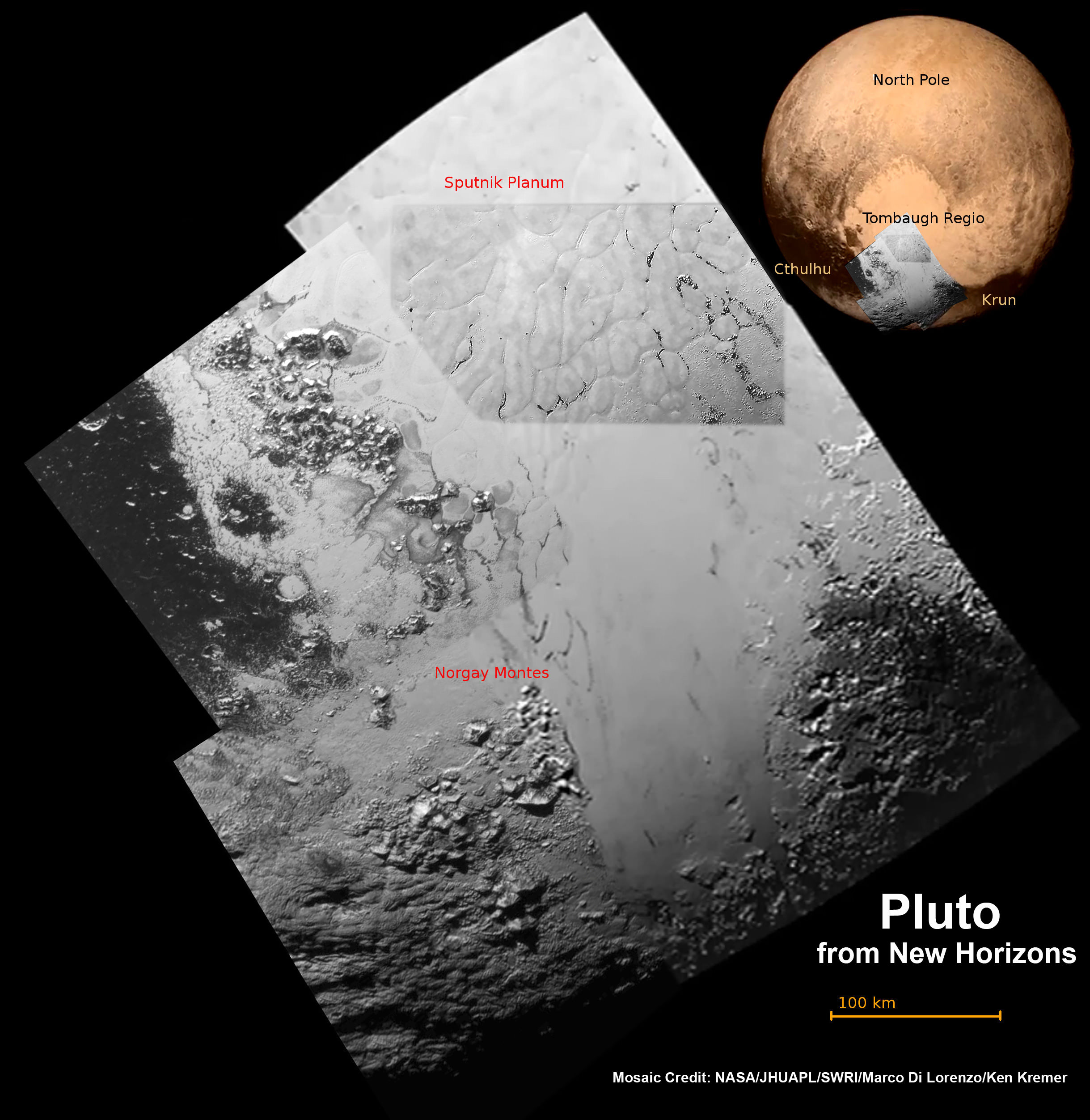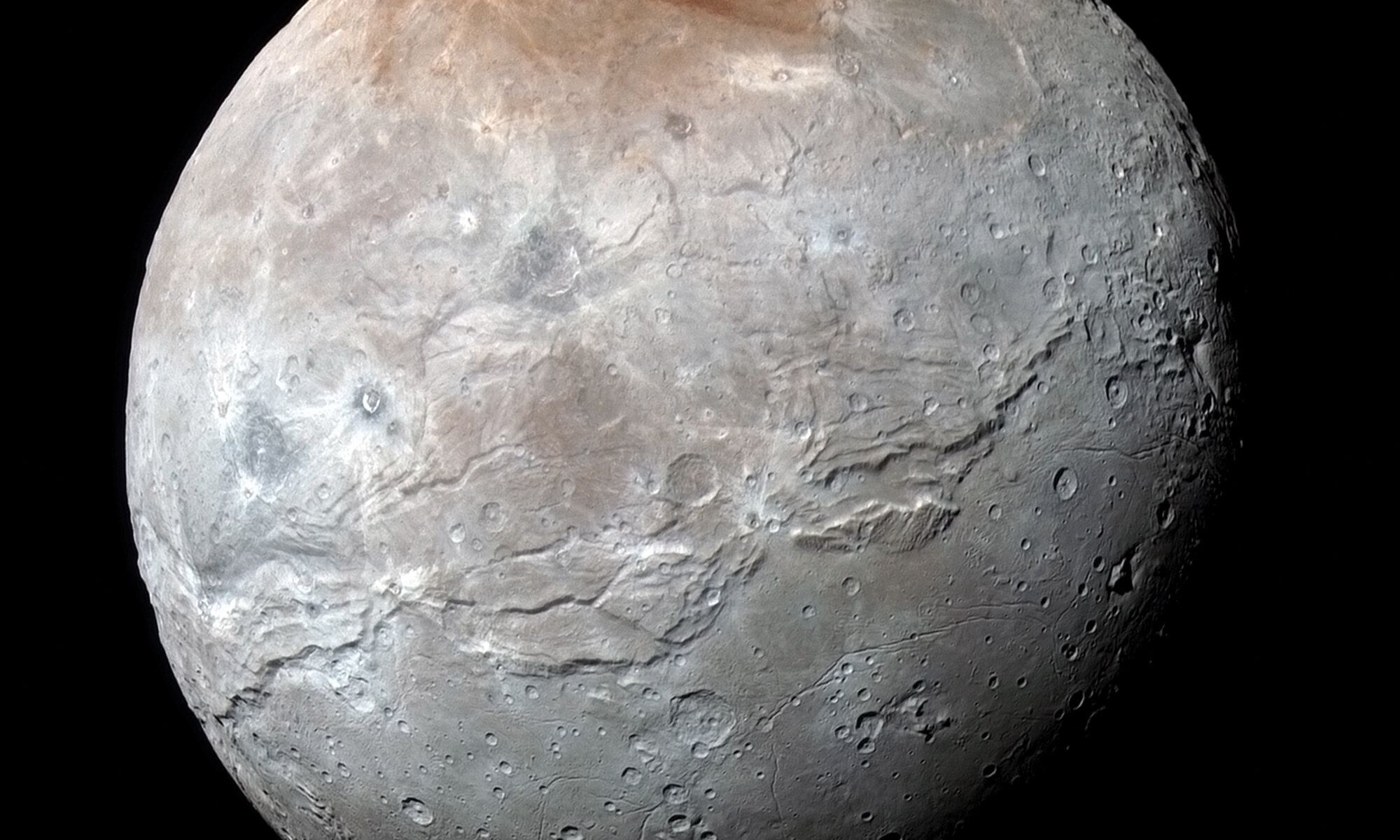Universe Today has examined the potential for sending humans to Jupiter’s icy moon, Europa, the planet Venus, and Saturn’s largest moon, Titan, all despite their respective harsh environments and vast distances. These conversations with planetary science experts determined that humans traveling to these worlds in the foreseeable future could be possible, despite the harsh conditions and travel time, specifically to Titan.
Continue reading “Should We Send Humans to Pluto?”Freezing Ocean Might Not Be Responsible for Cryovolcanic Flows on Pluto’s Moon, Charon
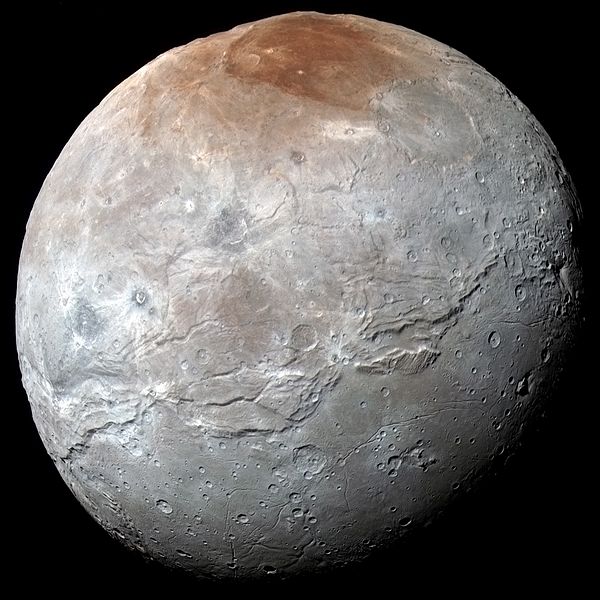
In a recent study scheduled to be published in the journal Icarus in March 2023, a team of researchers led by the Southwest Research Institute (SwRI) modeled a potential correlation between an ancient freezing ocean with cryovolcanic flows and surface canyons on Pluto’s largest moon, Charon. Their hypothesis was that when Charon’s interior ocean froze long ago, the significant stress put on the icy outer shell from the addition of more ice to the bottom of the existing shell could have been responsible for the cryovolcanic flows on the surface.
Continue reading “Freezing Ocean Might Not Be Responsible for Cryovolcanic Flows on Pluto’s Moon, Charon”Will Pluto finally answer, ‘Are we alone?’
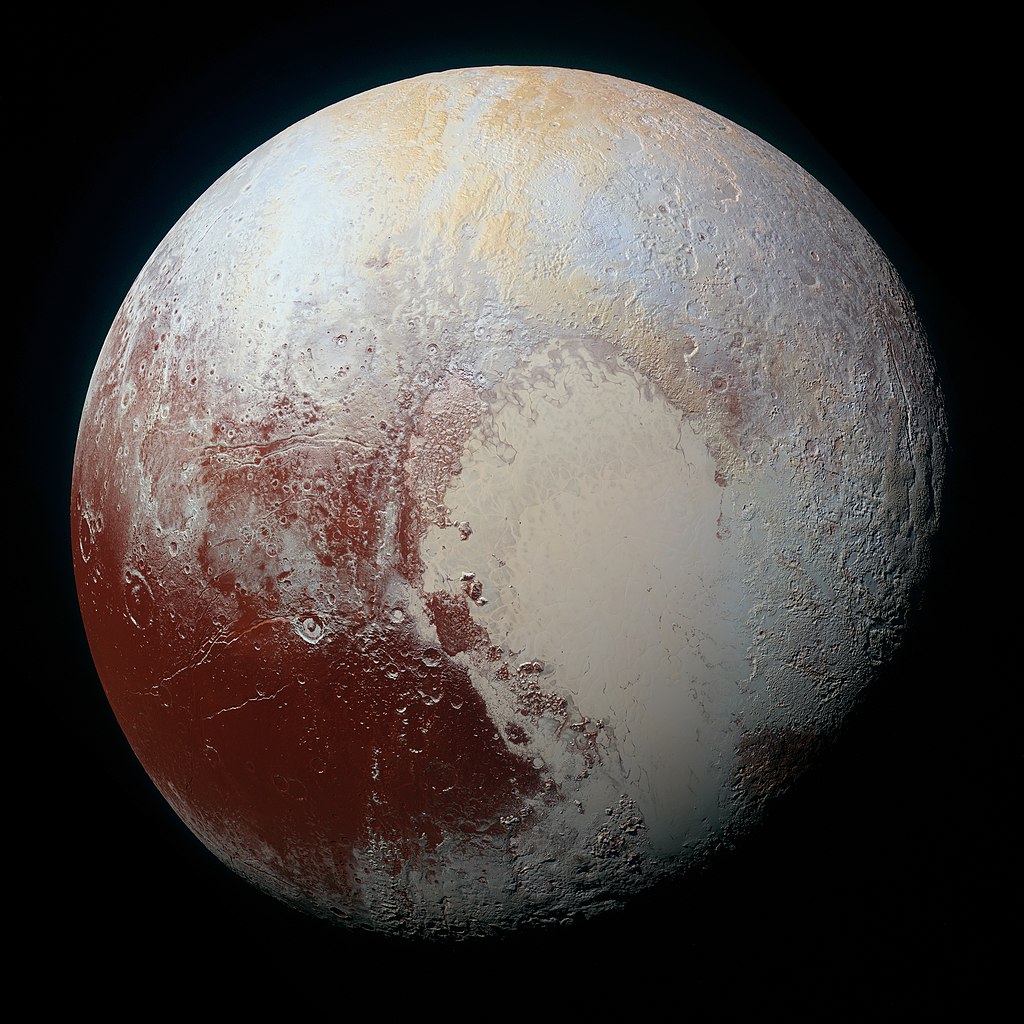
We previously examined how Neptune’s largest moon, Triton, could answer the longstanding question: Are we alone? With its nitrogen geysers discovered by NASA’s Voyager 2 spacecraft, possible interior ocean, and lack of craters, Triton could be geologically active, which makes it an excellent celestial body for future astrobiology missions. But Triton isn’t the only place on the edge of the solar system which garners interest for finding life beyond Earth, as one of the most familiar and well-known (former) planets also exhibits evidence of recent geological activity and crater-less surface features. This is everyone’s favorite dwarf planet, Pluto, which like Triton has only been visited by one spacecraft, this one being NASA’s New Horizons, in 2015. But even with only one visitation, we discovered so much about Pluto, and what it might be hiding, as well.
Continue reading “Will Pluto finally answer, ‘Are we alone?’”Charon’s Red Cap at its North Pole? We Might Have an Answer
Pluto’s largest moon, Charon, started off as a beautiful, smooth red grape until someone came along, mostly peeled it, tried to smoosh it, then just gave up and walked away, leaving the poor moon to look like the absolute travesty that it is. Okay, so maybe that’s not exactly what happened, but Charon just looks like a mess and scientists want to know why. Never mind its smooshed equator, but what’s the deal with its red cap? Where did it come from and why is it red?
Continue reading “Charon’s Red Cap at its North Pole? We Might Have an Answer”NASA Approves New Horizons Extended KBO Mission, Keeps Dawn at Ceres

In an ‘Independence Day’ gift to a slew of US planetary research scientists, NASA has granted approval to nine ongoing missions to continue for another two years this holiday weekend.
The biggest news is that NASA green lighted a mission extension for the New Horizons probe to fly deeper into the Kuiper Belt and decided to keep the Dawn probe at Ceres forever, rather than dispatching it to a record breaking third main belt asteroid.
And the exciting extension news comes just as the agency’s Juno probe is about to ignite a do or die July 4 fireworks display to achieve orbit at Jupiter – detailed here.
“Mission approved!” the researchers gleefully reported on the probes Facebook and Twitter social media pages.
“Our extended mission into the #KuiperBelt has been approved. Thanks to everyone for following along & hopefully the best is yet to come.

The New Horizons spacecraft will now continue on course in the Kuiper Belt towards an small object known as 2014 MU69, to carry out the most distant close encounter with a celestial object in human history.
“Here’s to continued success!”
The spacecraft will rendezvous with the ancient rock on New Year’s Day 2019.
Researchers say that 2014 MU69 is considered as one of the early building blocks of the solar system and as such will be invaluable to scientists studying the origin of our solar system how it evolved.
It was almost exactly one year ago on July 14, 2015 that New Horizons conducted Earth’s first ever up close flyby and science reconnaissance of Pluto – the most distant planet in our solar system and the last of the nine planets to be explored.
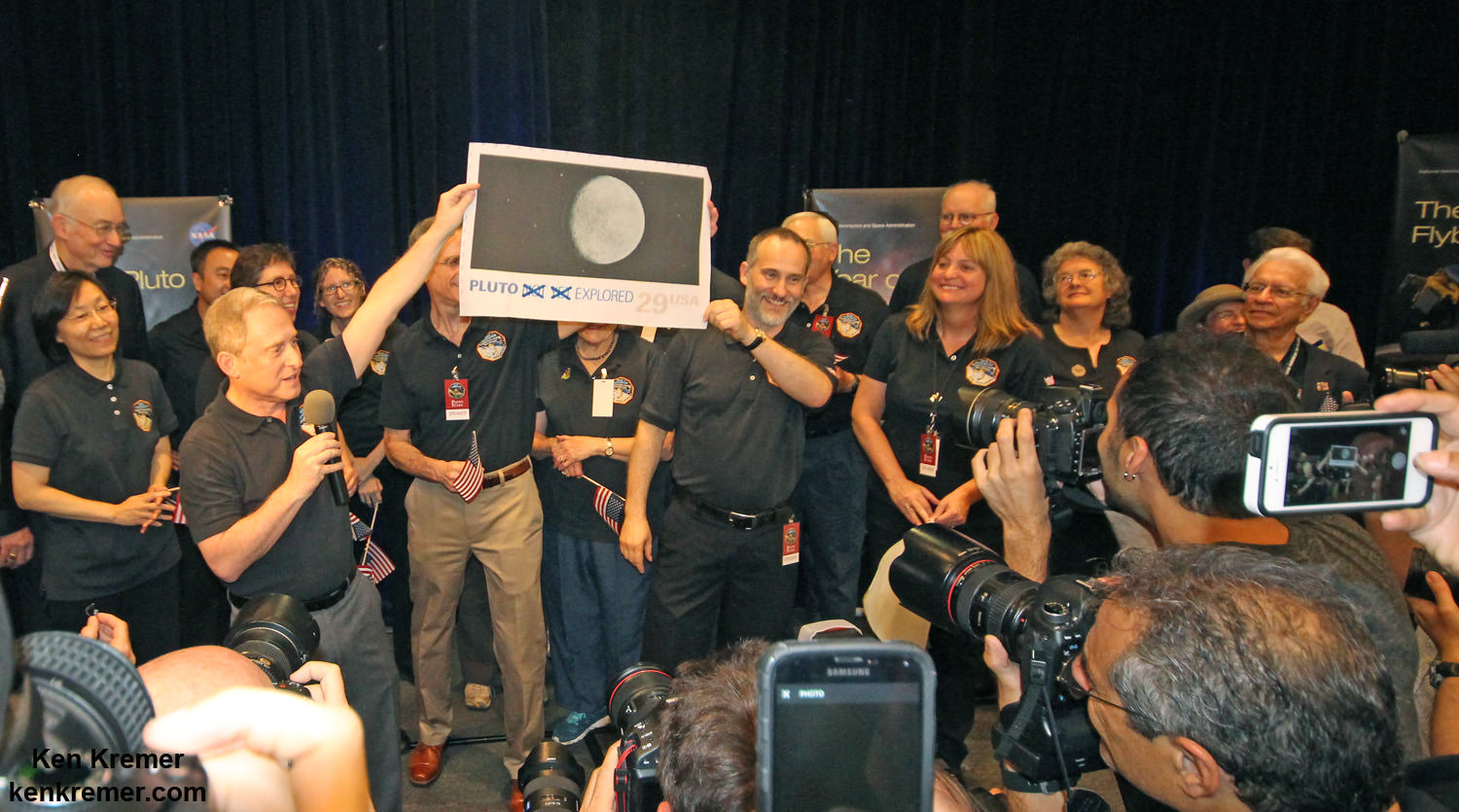
The immense volume of data gathered continues to stream back to Earth every day.
“The New Horizons mission to Pluto exceeded our expectations and even today the data from the spacecraft continue to surprise,” said NASA’s Director of Planetary Science Jim Green at NASA HQ in Washington, D.C.
“We’re excited to continue onward into the dark depths of the outer solar system to a science target that wasn’t even discovered when the spacecraft launched.”
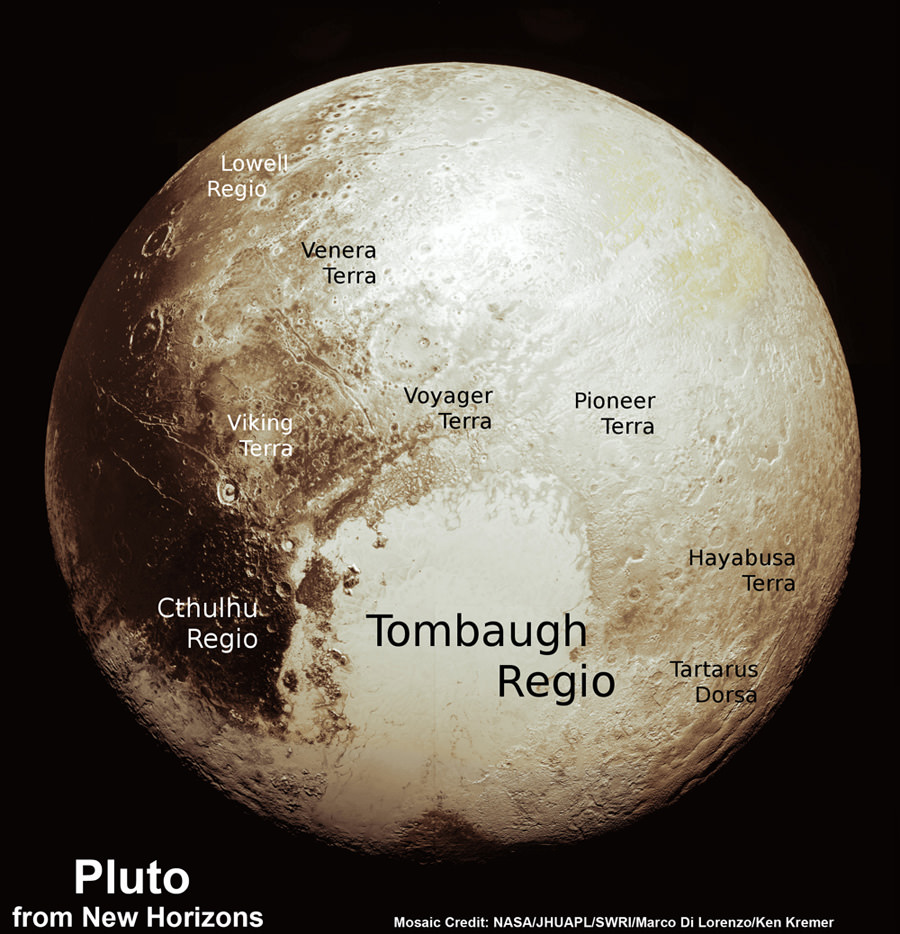
While waiting for news on whether NASA would approve an extended mission, the New Horizons engineering and science team already ignited the main engine four times to carry out four course changes in October and November 2015, in order to preserve the option of the flyby past 2014 MU69 on Jan 1, 2019.
Green noted that mission extensions into fiscal years 2017 and 2018 are not final until Congress actually passes sufficient appropriation to fund NASA’s Planetary Science Division.
“Final decisions on mission extensions are contingent on the outcome of the annual budget process.”
Tough choices were made even tougher because the Obama Administration has cut funding for the Planetary Sciences Division – some of which was restored by a bipartisan majority in Congress for what many consider NASA’s ‘crown jewels.’
NASA’s Dawn asteroid orbiter just completed its primary mission at dwarf planet Ceres on June 30, just in time for the global celebration known as Asteroid Day.
“The mission exceeded all expectations originally set for its exploration of protoplanet Vesta and dwarf planet Ceres,” said NASA officials.
The Dawn science team had recently submitted a proposal to break out of orbit around the middle of this month in order to this conduct a flyby of the main belt asteroid Adeona.
Green declined to approve the Dawn proposal, citing additional valuable science to be gathered at Ceres.
The long-term monitoring of Ceres, particularly as it gets closer to perihelion – the part of its orbit with the shortest distance to the sun — has the potential to provide more significant science discoveries than a flyby of Adeona,” he said.
The funding required for a multi-year mission to Adeona would be difficult in these cost constrained times.
However the spacecraft is in excellent shape and the trio of science instruments are in excellent health.
Dawn arrived at Ceres on March 6, 2015 and has been conducting unprecedented investigation ever since.
Dawn is Earth’s first probe in human history to explore any dwarf planet, the first to explore Ceres up close and the first to orbit two celestial bodies.
The asteroid Vesta was Dawn’s first orbital target where it conducted extensive observations of the bizarre world for over a year in 2011 and 2012.
The mission is expected to last until at least later into 2016, and possibly longer, depending upon fuel reserves.
Due to expert engineering and handling by the Dawn mission team, the probe unexpectedly has hydrazine maneuvering fuel leftover.
Dawn will remain at its current altitude at the Low Altitude Mapping Orbit (LAMO) for the rest of its mission, and indefinitely afterward, even when no further communications are possible.
Green based his decision on the mission extensions on the biannual peer review scientific assessment by the Senior Review Panel.
Dawn was launched in September 2007.
The other mission extensions – contingent on available resources – are: the Mars Reconnaissance Orbiter (MRO), Mars Atmosphere and Volatile EvolutioN (MAVEN), the Opportunity and Curiosity Mars rovers, the Mars Odyssey orbiter, the Lunar Reconnaissance Orbiter (LRO), and NASA’s support for the European Space Agency’s Mars Express mission.
Stay tuned here for Ken’s continuing Earth and planetary science and human spaceflight news.
New Horizons Snaps Amazing 3-D View of Pluto’s Mysterious ‘Bladed’ Terrain
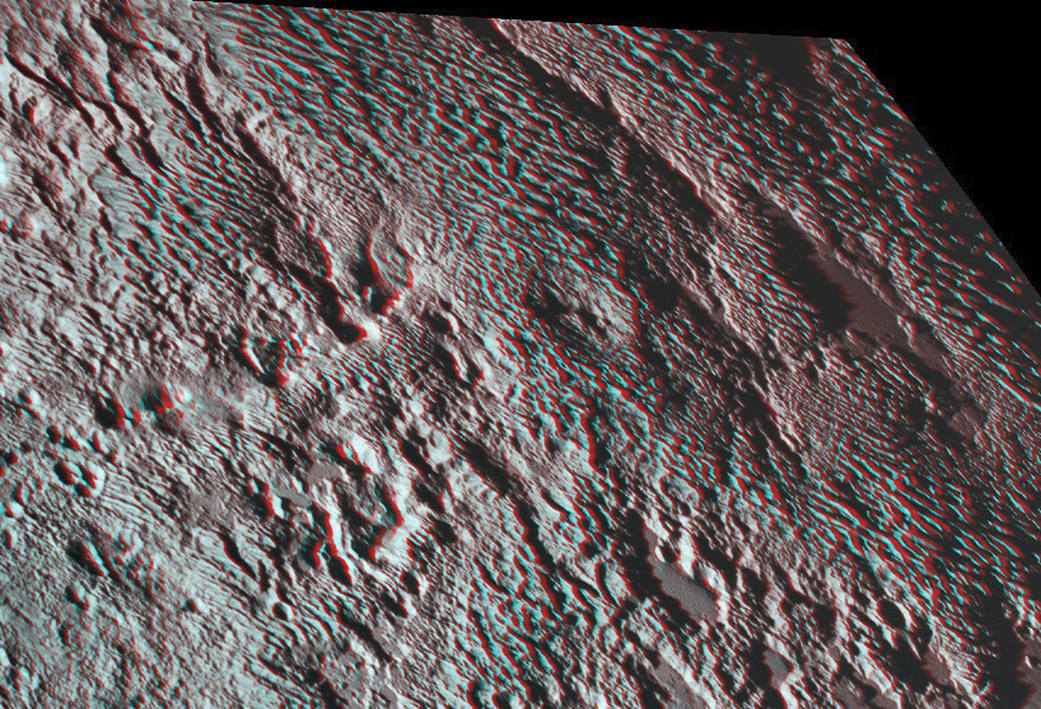

It’s time to whip out your 3-D glasses to enjoy and scrutinize the remarkable detail of spectacular terrain revealed in a new high resolution stereo image of Pluto – King of the Kuiper Belt! – taken by NASA’s New Horizons spacecraft.
The amazing new stereo Plutonian image focuses on an area dominated by a mysterious feature that geologists call ‘bladed’ terrain – seen above – and its unlike anything seen elsewhere in our solar system.
Its located in a broad region of rough highlands informally known as Tartarus Dorsa – situated to the east of the Pluto’s huge heart shaped feature called Tombaugh Regio. The best resolution is approximately 1,000 feet (310 meters).
The stereo view combines a pair of images captured by New Horizons Ralph/Multispectral Visible Imaging Camera (MVIC) science instruments. They were taken about 14 minutes apart on during history making first ever flyby of the Pluto planetary system on July 14, 2015.
The first was taken when New Horizons was 16,000 miles (25,000 kilometers) away from Pluto, the second when the spacecraft was 10,000 miles (about 17,000 kilometers) away.
The blades align from north to south, typically reach up to about 550 yards (500 meters) high and are spaced about 2-4 miles (3-5 kilometers). Thus they are among the planets steepest features. They are “perched on a much broader set of rounded ridges that are separated by flat valley floors,” according to descriptions from the New Horizons science team.

Mission scientists have also noted that the bladed terrain has the texture of “snakeskin” owing to their “scaly raised relief.”
In the companion global image from NASA (below), the bladed terrain is outlined in red and shown to extend quite far to the east of Tombaugh Regio.
The composite image was taken on July 13, 2015, the day before the closest approach flyby, when the probe was farther away thus shows lower resolution. It combines a pair of images from two of the science instruments – a Ralph/Multispectral Visible Imaging Camera (MVIC) color scan and an image from the Long Range Reconnaissance Imager (LORRI).
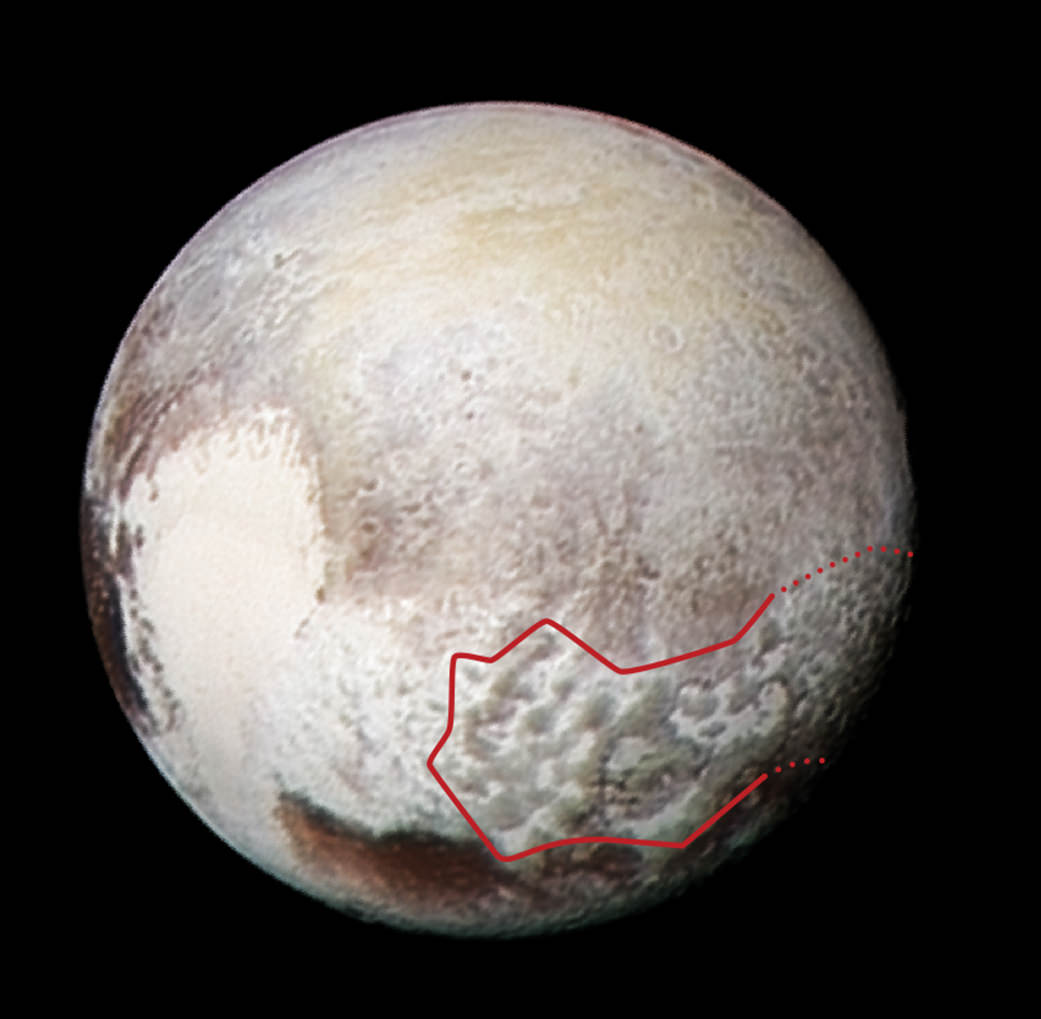
Credits: NASA/JHUAPL/SwRI
The MVIC scan was taken from a range of 1 million miles (1.6 million kilometers), at a resolution of 20 miles (32 kilometers) per pixel. The corresponding LORRI image was obtained from roughly the same range, but has a higher spatial resolution of 5 miles (8 kilometers) per pixel, say officials.
Scientists have developed several possible theories about the origins of the bladed terrain, including erosion from evaporating ices or deposition of methane ices.
Measurements from the Linear Etalon Imaging Spectral Array (LEISA) instrument reveal that that this region “is composed of methane (CH4) ice with a smattering of water,” reports New Horizons researcher Orkan Umurhan.
He speculates that “the material making up the bladed terrain is a methane clathrate. A clathrate is a structure in which a primary molecular species (say water, or H2O) forms a crystalline ‘cage’ to contain a guest molecule (methane or CH4, for example).”
But the question of whether that methane ice is strong enough to maintain the steep walled snakeskin features, will take much more research to determine a conclusive answer.
Umurhan suggests that more research could help determine if the “methane clathrates in the icy moons of the outer solar system and also in the Kuiper Belt were formed way back before the solar system formed – i.e., within the protosolar nebula – potentially making them probably some of the oldest materials in our solar system.”
Pluto continues to amaze and surprise us as the data streams back to eagerly waiting scientists on Earth over many more months to come – followed by years and decades of painstaking analysis.

During New Horizons flyby on July 14, 2015, it discovered that Pluto is the biggest object in the outer solar system and thus the ‘King of the Kuiper Belt.”
The Kuiper Belt comprises the third and outermost region of worlds in our solar system.
Pluto is the last planet in our solar system to be visited in the initial reconnaissance of planets by spacecraft from Earth since the dawn of the Space Age.
New Horizons remains on target to fly by a second Kuiper Belt Object (KBO) on Jan. 1, 2019 – tentatively named PT1, for Potential Target 1. It is much smaller than Pluto and was recently selected based on images taken by NASA’s Hubble Space Telescope.
Stay tuned here for Ken’s continuing Earth and planetary science and human spaceflight news.
………….
Learn more about NASA Mars rovers, Orion, SLS, ISS, Orbital ATK, ULA, SpaceX, Boeing, Space Taxis, NASA missions and more at Ken’s upcoming outreach events:
Apr 9/10: “NASA and the Road to Mars Human Spaceflight programs” and “Curiosity explores Mars” at NEAF (NorthEast Astronomy and Space Forum), 9 AM to 5 PM, Suffern, NY, Rockland Community College and Rockland Astronomy Club – http://rocklandastronomy.com/neaf.html
Apr 12: Hosting Dr. Jim Green, NASA, Director Planetary Science, for a Planetary sciences talk about “Ceres, Pluto and Planet X” at Princeton University; 7:30 PM, Amateur Astronomers Assoc of Princeton, Peyton Hall, Princeton, NJ – http://www.princetonastronomy.org/
Apr 17: “NASA and the Road to Mars Human Spaceflight programs”- 1:30 PM at Washington Crossing State Park, Nature Center, Titusville, NJ – http://www.state.nj.us/dep/parksandforests/parks/washcros.html
“X” Marks the Spot of Convective Churning on Hot Pluto
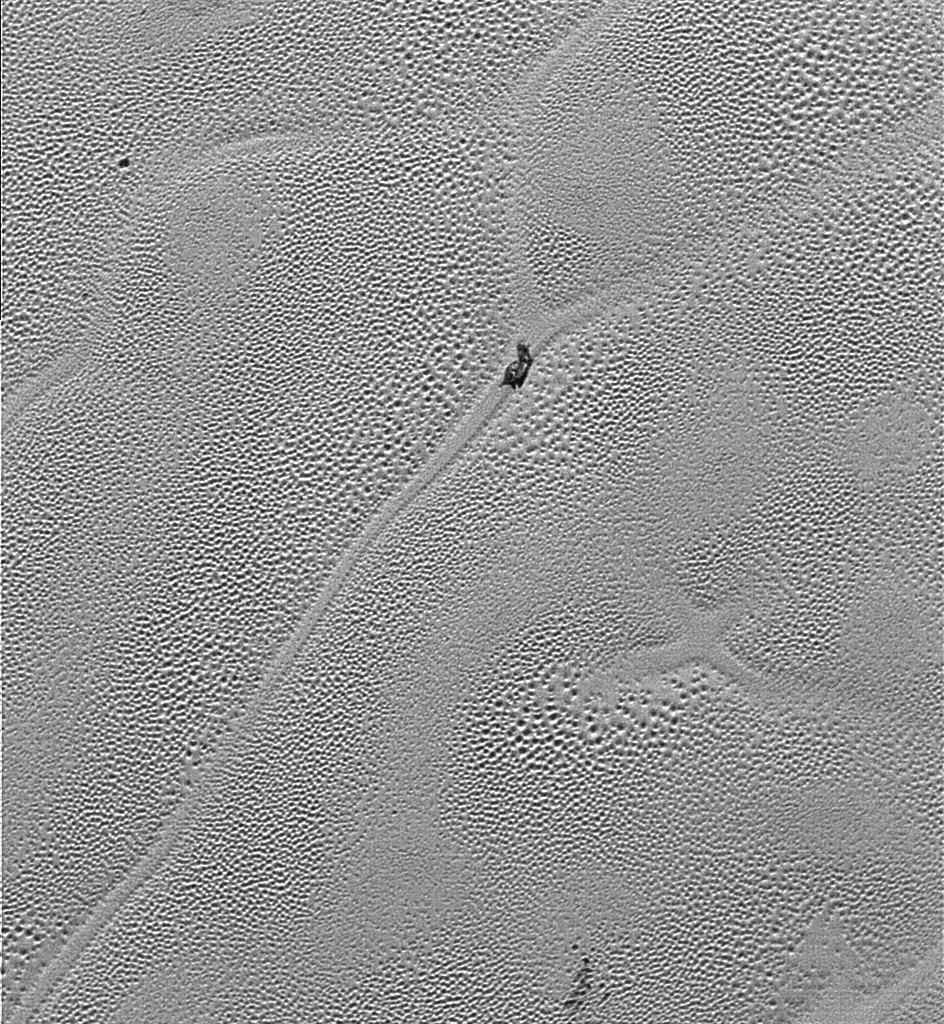
“X” marks the spot that’s illustrative of “convective churning” resulting from subsurface planetary heating, as seen in a fascinating new super high resolution image received from NASA’s New Horizons spacecraft on Christmas Eve, Dec. 24, 2015. Its situated at the very center of the left ventricle of Pluto’s huge “heart” – an icy flow plain that’s informally named “Sputnik Planum.”
The “X” feature – see image above – is located in an area of intersecting cells, shaped like polygons, on the plains of “Sputnik Planum” which are mostly comprised of frozen nitrogen ices.
Continue reading ““X” Marks the Spot of Convective Churning on Hot Pluto”
Possible Ice Volcanoes Discovered on Pluto
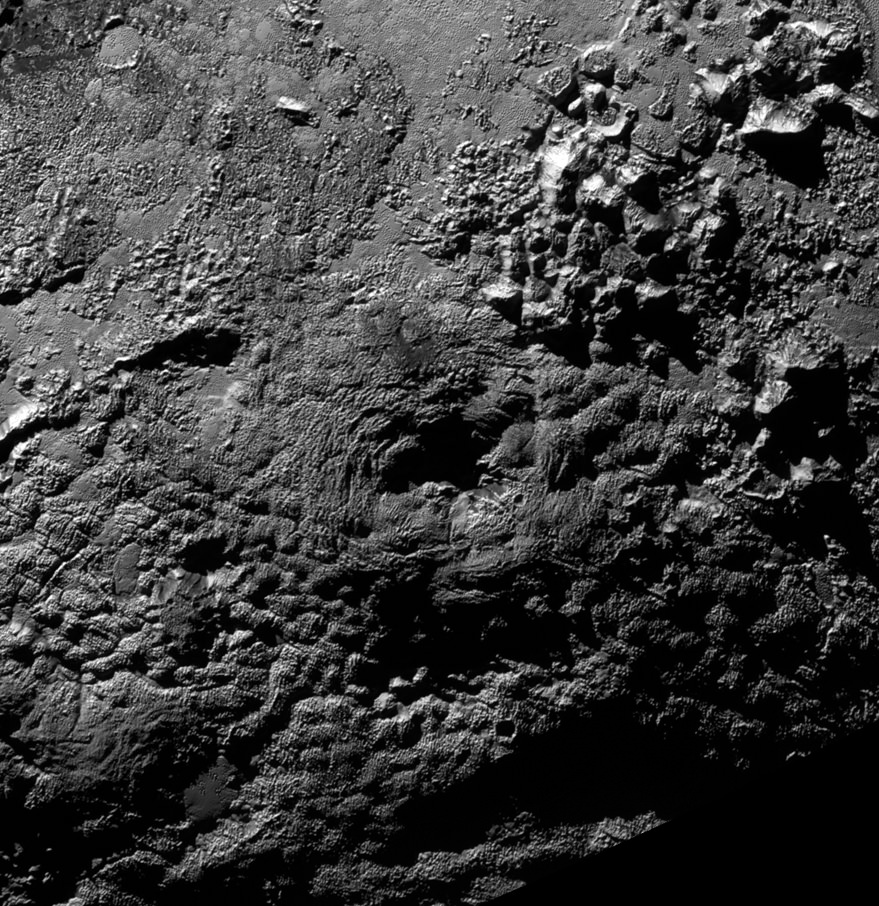
Ice Volcanoes on Pluto?
The informally named feature Wright Mons, located south of Sputnik Planum on Pluto, is an unusual feature that’s about 100 miles (160 kilometers) wide and 13,000 feet (4 kilometers) high. It displays a summit depression (visible in the center of the image) that’s approximately 35 miles (56 kilometers) across, with a distinctive hummocky texture on its sides. The rim of the summit depression also shows concentric fracturing. New Horizons scientists believe that this mountain and another, Piccard Mons, could have been formed by the ‘cryovolcanic’ eruption of ices from beneath Pluto’s surface. Credit: NASA/Johns Hopkins University Applied Physics Laboratory/Southwest Research Institute[/caption]
The possible discovery of a pair of recently erupting ice volcanoes on Pluto are among the unexpected “astounding” findings just unveiled by perplexed scientists with NASA’s New Horizons spacecraft, barely four months after the historic first flyby of the last unexplored planet in our solar system.
“Nothing like this has been seen in the deep outer solar system,” said Jeffrey Moore, New Horizons Geology, Geophysics and Imaging team leader from NASA Ames Research Center, Moffett Field, California, as the results so far were announced at the 47th Annual Meeting of the Division for Planetary Sciences (DPS) of the American Astronomical Society (AAS) this week in National Harbor, Maryland.
“The Pluto system is baffling us,” said mission Principal Investigator Alan Stern of the Southwest Research Institute, Boulder, Colorado, at a news media briefing on Nov. 9.
Two large mountainous features tens of miles across and several miles high, have been potentially identified by the team as volcanoes.
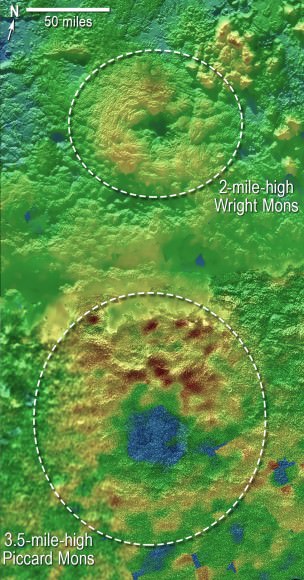
They were found in terrain located south of Sputnik Planum – a vast area of smooth icy plains located within Pluto’s huge heart shaped region informally known as Tombaugh Regio. It may have formed very recently resulting from geologic activity within the past 10 million years.
The possible ice volcanoes, or cryovolcanoes, were found at two of Pluto’s most distinctive mountains and identified from images taken by New Horizons as it became Earth’s first emissary to hurtle past the small planet on July 14, 2015.
“All of our flyby plans succeeded,” Stern stated at the briefing.
“All of the data sets are spectacular.
Scientists created 3-D topographic maps from the probes images and discovered the possible ice volcanoes – informally named Wright Mons and Piccard Mons.
Wright Mons, pictured above, is about 100 miles (160 kilometers) wide and 13,000 feet (4 kilometers) high.
Both mountains appear to show summit depressions “with a large hole” visible in the center, similar to volcanoes on Earth. Scientists speculate “they may have formed by the ‘cryovolcanic’ eruption of ices from beneath Pluto’s surface.”
The erupting Plutonian ices might be composed of a melted slurry of water ice, nitrogen, ammonia and methane.
The depression inside Wright Mons is approximately 35 miles (56 kilometers) across and exhibits a “distinctive hummocky texture on its sides. The rim of the summit depression also shows concentric fracturing.”
“These are big mountains with a large hole in their summit, and on Earth that generally means one thing—a volcano,” said Oliver White, New Horizons postdoctoral researcher with NASA Ames, in a statement.
The team is quick to caution that the “interpretation of these features as volcanoes is tentative” and requires much more analysis.
“If they are volcanic, then the summit depression would likely have formed via collapse as material is erupted from underneath. The strange hummocky texture of the mountain flanks may represent volcanic flows of some sort that have travelled down from the summit region and onto the plains beyond, but why they are hummocky, and what they are made of, we don’t yet know.”
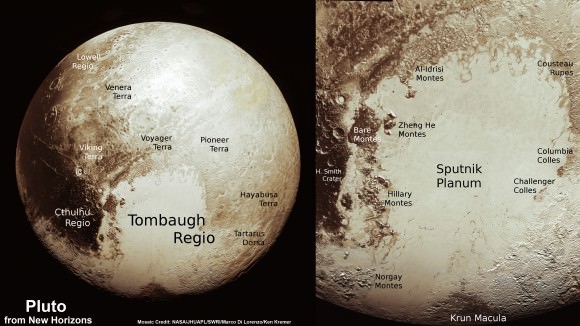
More than 50 papers about the Pluto system are being presented at the AAS meeting this week.
So far New Horizon has transmitted back only about 20 percent of the data gathered, according to mission Principal Investigator Alan Stern.
“It’s hard to imagine how rapidly our view of Pluto and its moons are evolving as new data stream in each week. As the discoveries pour in from those data, Pluto is becoming a star of the solar system,” said Stern.
“Moreover, I’d wager that for most planetary scientists, any one or two of our latest major findings on one world would be considered astounding. To have them all is simply incredible.”
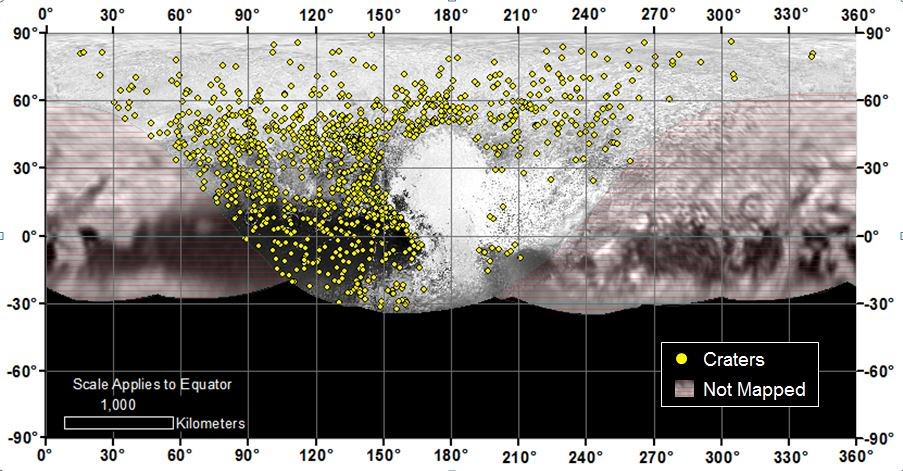
The piano shaped probe gathered about 50 gigabits of data as it hurtled past Pluto, its largest moon Charon and four smaller moons.
Stern says it will take about a year for all the data to get back. Thus bountiful new discoveries are on tap for a long time to come.
With 20 percent of the data now returned and more streaming back every day, the team is excited to debate what is all means.
“This is when the debates begin,” said Curt Niebur, New Horizons program scientist at NASA Headquarters, at the missions Nov 9 media briefing. “This is when the heated discussions begin. This is when the entire science community starts staying up throughout the night.”
Stay tuned here for Ken’s continuing Earth and planetary science and human spaceflight news.
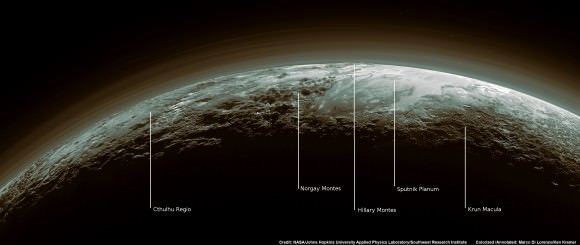
Astonishing ‘Snakeskin’ Textured Mountains Discovered on Pluto

The more we learn about Pluto, the weirder and weirder it gets.
The newest batch of high resolution Plutonian images has yielded “astonishing” discoveries of previously unseen ‘snakeskin’ textured mountains, that are simultaneously “dazzling and mystifying” scientists analyzing the latest data just returned from NASA’s New Horizons spacecraft.
New Horizons swooped past the Pluto planetary system during mankind’s history making first encounter on July 14, 2015 at a distance of 50,000 miles (80,000 kilometers).
The piano shaped probe gathered about 50 gigabits of data as it hurtled past Pluto, its largest moon Charon and four smaller moons.
Data from that priceless, once in a lifetime flyby is now trickling back to Earth.
The ‘snakeskin’ feature on Pluto’s utterly bizarre surface was unveiled to “astonished” scientists scrutinizing the latest data dump received over the past week, that included images taken by the Ralph instruments Multispectral Visual Imaging Camera (MVIC).
Features as small as 0.8 miles (1.3 kilometers) are resolved in detail.
The MVIC image stretches about 330 miles (530 kilometers) across the ‘snakeskin’ like landscape composed of rounded and bizarrely textured mountains that are informally named Tartarus Dorsa and that borders the bodies day-night terminator.
It shows intricate patterns of blue-gray ridges and reddish material in between that are puzzling researchers.
“It’s a unique and perplexing landscape stretching over hundreds of miles,” said William McKinnon, New Horizons Geology, Geophysics and Imaging (GGI) team deputy lead from Washington University in St. Louis.
“It looks more like tree bark or dragon scales than geology. This’ll really take time to figure out; maybe it’s some combination of internal tectonic forces and ice sublimation driven by Pluto’s faint sunlight.”
The Ralph/MVIC image is actually a composite of blue, red and infrared images.
The image of Tartarus Dorsa reveals a “multitude of previously unseen topographic and compositional details. It captures a vast rippling landscape of strange, aligned linear ridges that has astonished New Horizons team members,” say officials.
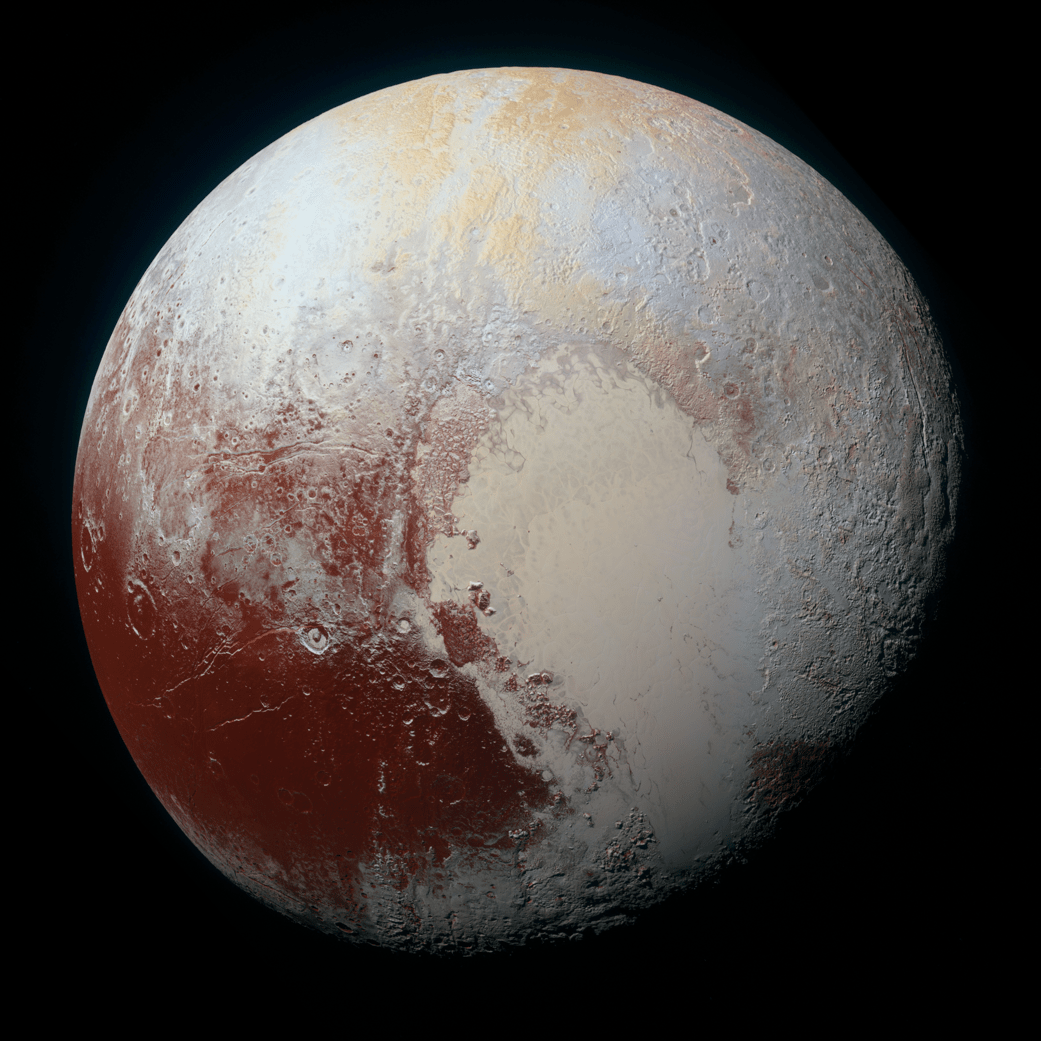
Another wider angle global view of Pluto downlinked on Sept. 19 shows a new “extended color” view of Pluto with an the extraordinarily rich color palette of the planet.
“We used MVIC’s infrared channel to extend our spectral view of Pluto,” said John Spencer, a GGI deputy lead from Southwest Research Institute (SwRI) in Boulder, Colorado.
“Pluto’s surface colors were enhanced in this view to reveal subtle details in a rainbow of pale blues, yellows, oranges, and deep reds. Many landforms have their own distinct colors, telling a wonderfully complex geological and climatological story that we have only just begun to decode.”
The image resolves details and colors on scales as small as 0.8 miles (1.3 kilometers).

Beyond MVIC, additional new images taken by New Horizons’ narrow-angle Long Range Reconnaissance Imager (LORRI) during the July 14 were downlinked on Sept. 20.
They focus on the Sputnik Planum ice plains on the left side of the famous heart shaped Tombaugh Regio feature and are the highest resolution yet – as seen below. The team added color based on the global MVIC map shown above.
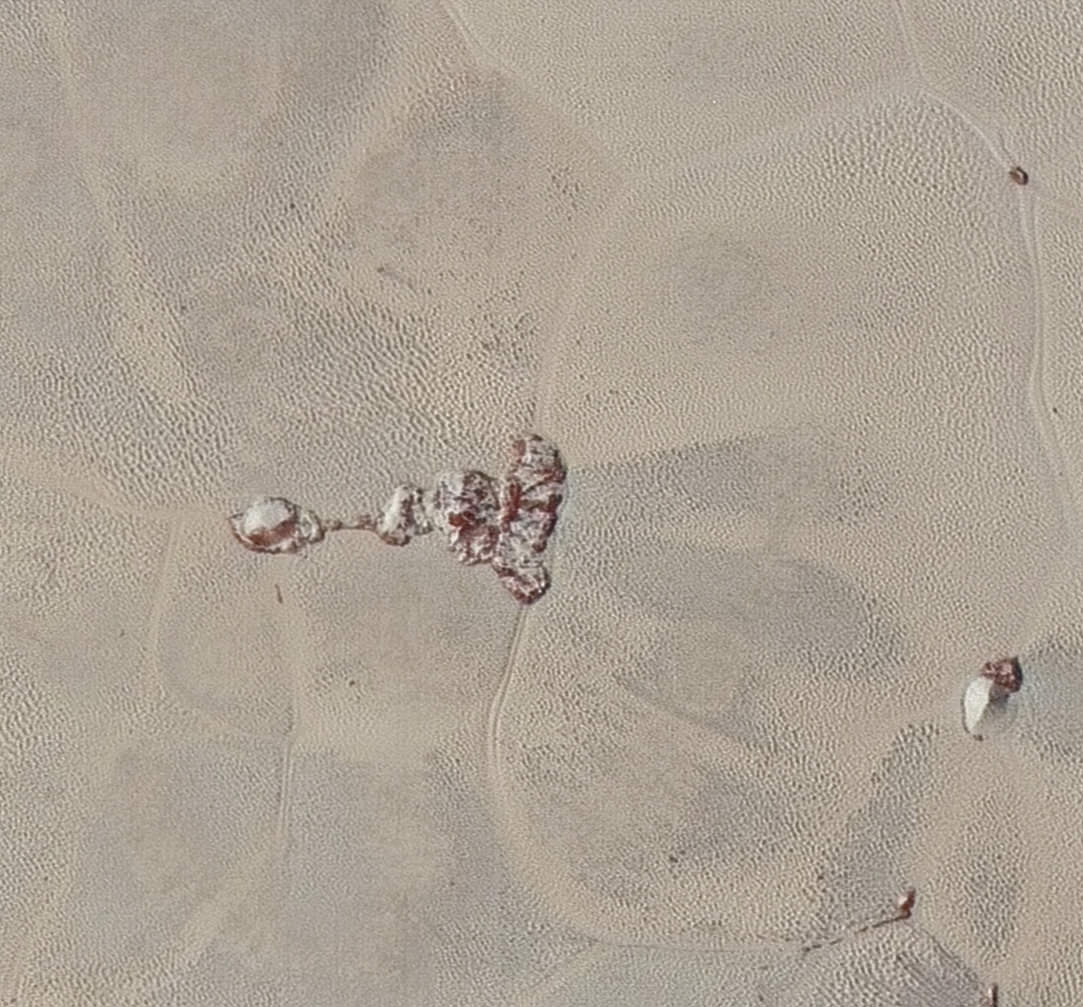
Barely 5 or 6 percent of the 50 gigabits of data captured by New Horizons has been received by ground stations back on Earth.
“With these just-downlinked images and maps, we’ve turned a new page in the study of Pluto beginning to reveal the planet at high resolution in both color and composition,” added New Horizons Principal Investigator Alan Stern, of SwRI.
“I wish Pluto’s discoverer Clyde Tombaugh had lived to see this day.”
Stern says it will take about a year for all the data to get back. Thus bountiful new discoveries are on tap.
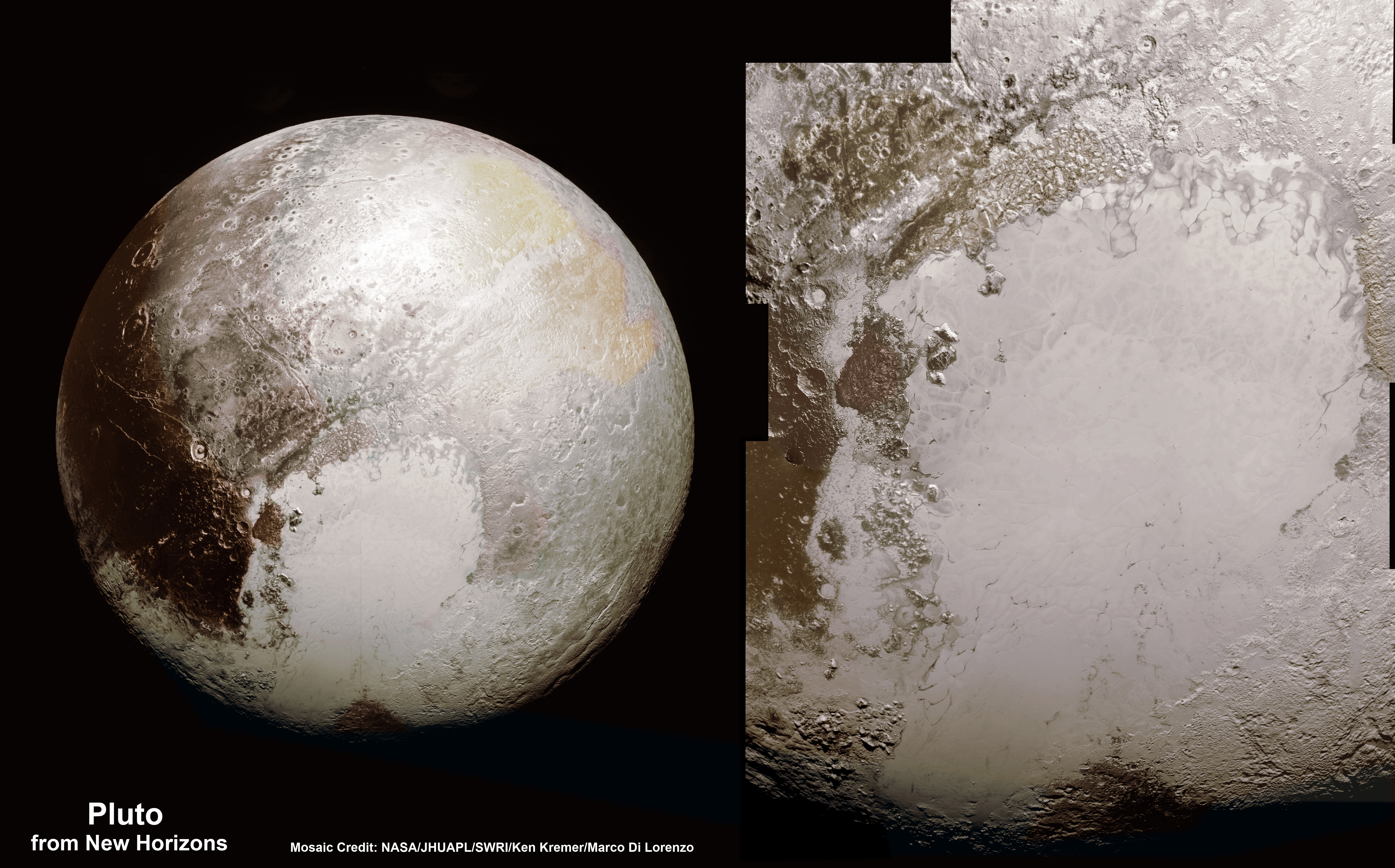
Stay tuned here for Ken’s continuing Earth and planetary science and human spaceflight news.
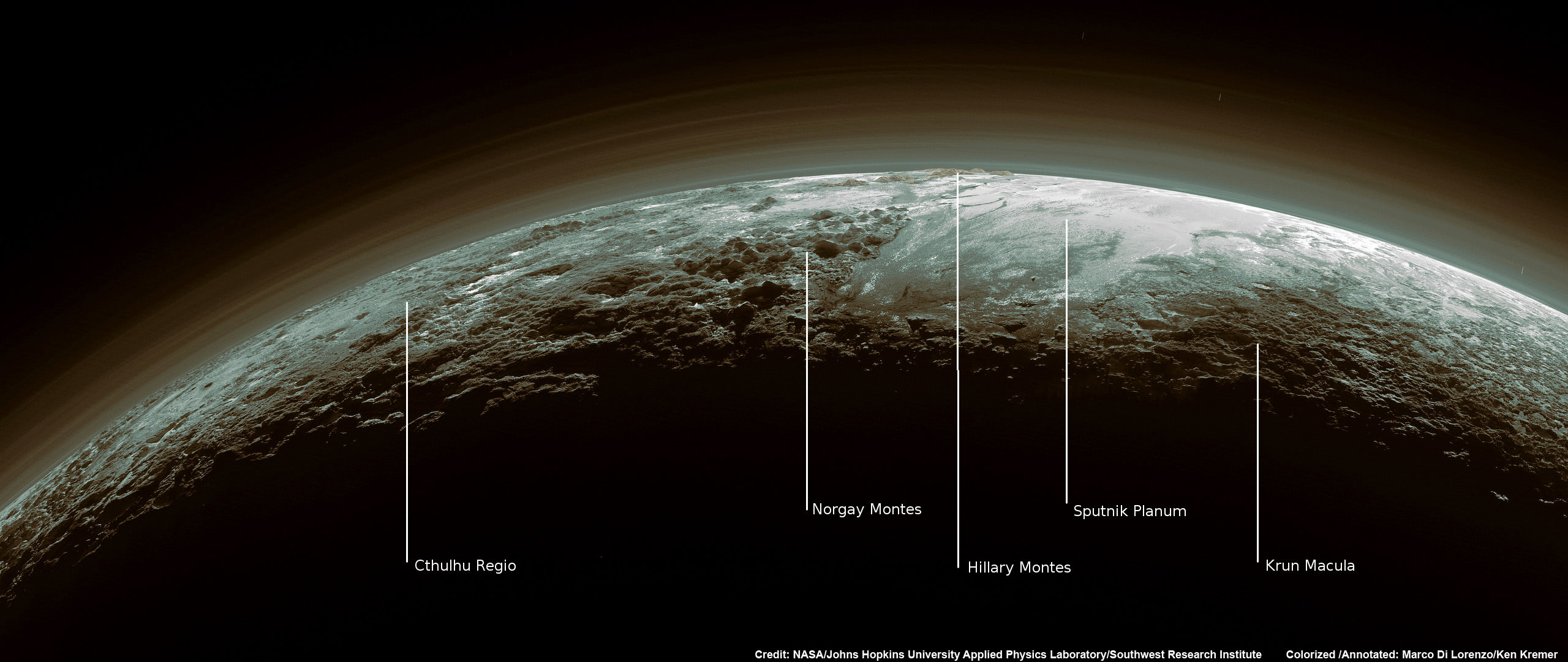
Flowing Ice, Exotic Mountains and Backlit Haze Highlight Pluto as Never Seen Before

Spectacular imagery of huge regions of flowing ice, monumental mountain ranges and a breathtakingly backlit atmospheric haze showing Pluto as we’ve never seen it before, were among the newest discoveries announced today, July 24, by scientists leading NASA’s New Horizons mission which sped past the planet for humanity’s first ever up-close encounter only last week.
New Horizon’s revealed Pluto be an unexpectedly vibrant “icy world of wonders” as it barreled by the Pluto-Charon double planet system last Tuesday, July 14, at over 31,000 mph (49,600 kph).
The scientists publicly released a series of stunning new images and science discoveries at Pluto that exceeded all pre-flyby expectations.
“The images of Pluto are spectacular,” said John Grunsfeld, NASA’s associate administrator for the Science Mission Directorate, at today’s media briefing.
“We knew that a mission to Pluto would bring some surprises, and now — 10 days after closest approach — we can say that our expectation has been more than surpassed. With flowing ices, exotic surface chemistry, mountain ranges, and vast haze, Pluto is showing a diversity of planetary geology that is truly thrilling.”
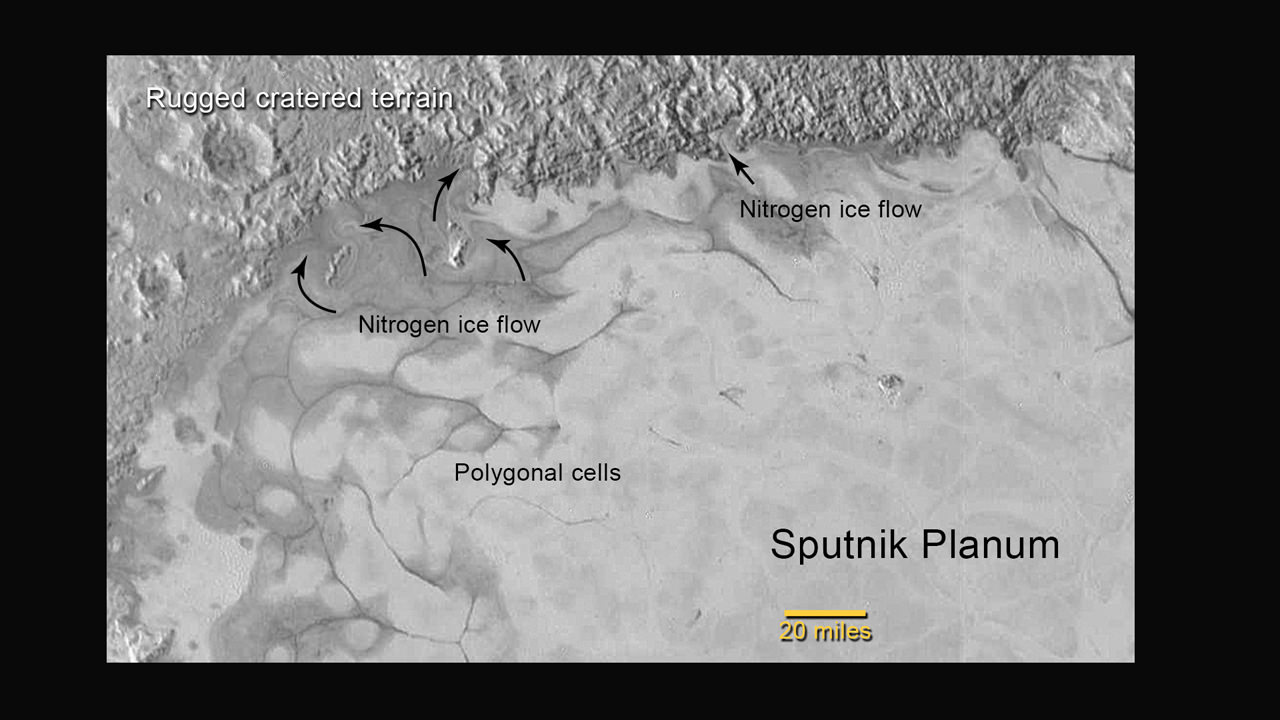
Over 50 gigabits of data were collected during the encounter and flyby periods of the highest scientific activity in the most critical hours before and after the spacecrafts closest approach to Pluto, its largest moon Charon and its quartet of smaller moons.
Data from the flyby is now raining back to Earth, but slowly due to limited bandwidth of an average “downlink” of only about 2 kilobits per second via its two transmitters.
“So far we’ve seen only about 5% of the encounter data,” said Jim Green, director of Planetary Science at NASA Headquarters in Washington.
At that pace it will take about 16 months to send all the flyby science data back to Earth.
Among the top highlights is the first view ever taken from the back side of Pluto, a backlit view that humans have never seen before.
It shows a global portrait of the planets extended atmosphere and was captured when NASA’s New Horizons spacecraft was about 1.25 million miles (2 million kilometers) from Pluto. It shows structures as small as 12 miles across.
“The silhouette of Pluto taken after the flyby and show a remarkable haze of light representing the hazy worlds extended atmosphere,” Alan Stern, principal investigator for New Horizons at the Southwest Research Institute (SwRI) in Boulder, Colorado, said at the media briefing.
“The image is the equivalent of the Apollo astronauts Earth-rise images.”
“It’s the first image of Pluto’s atmosphere!” said Michael Summers, New Horizons co-investigator at George Mason University in Fairfax, Virginia, at the briefing.
“We’ve known about the atmosphere for over 25 years,” and now we can see it. There are haze layers and it shows structure and weather. There are two distinct layers of haze. One at about 30 miles (50 kilometers) and another at about 50 miles (80 kilometers) above the surface.”
“The haze extend out about 100 miles! Which is five times more than expected.”
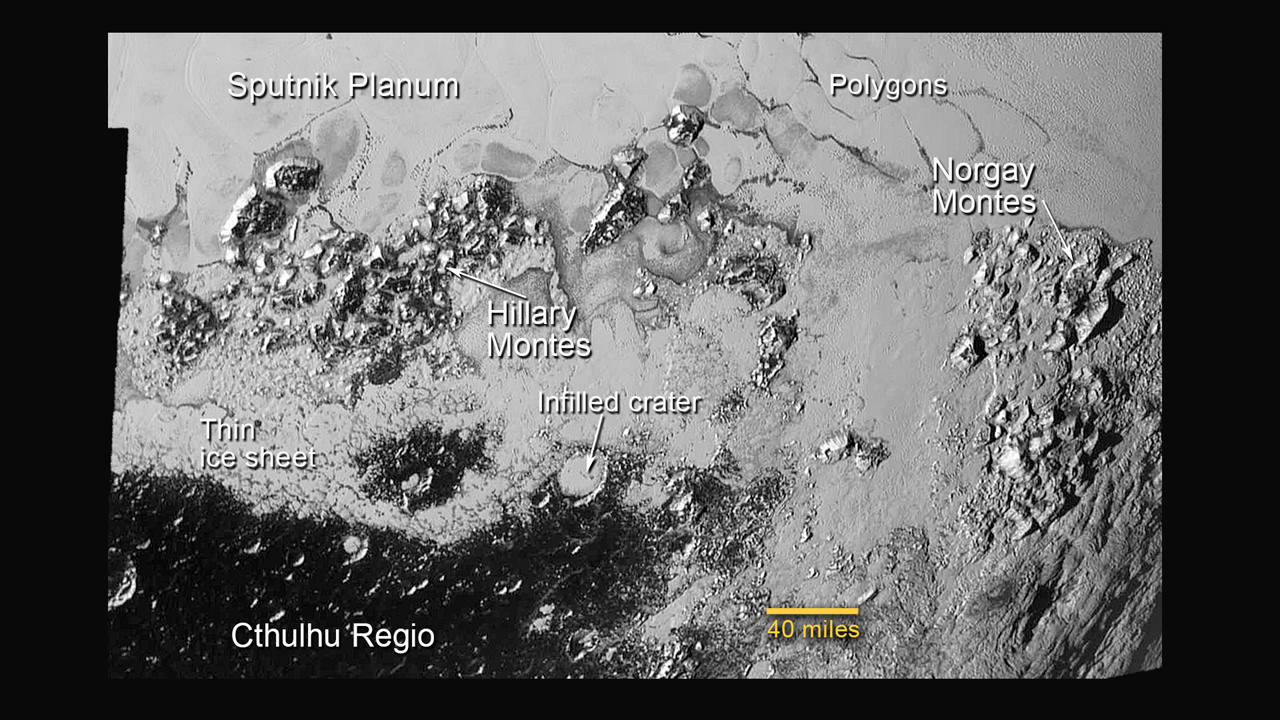
The image was taken by New Horizons’ high resolution Long Range Reconnaissance Imager (LORRI) while looking back at Pluto, barely seven hours after closest approach at 7:49 a.m. EDT on July 14, and gives significant clues about the atmosphere’s dynamics and interaction with the surface. It captures sunlight streaming through the atmosphere.
“The hazes detected in this image are a key element in creating the complex hydrocarbon compounds that give Pluto’s surface its reddish hue.”
Methane (CH4) in the upper atmosphere break down by interaction of UV radiation and forms ethylene and acetylene which leads to more complex hydrocarbons known as tholins – which the team says is responsible for Pluto’s remarkable reddish hue.
The team also released new LORRI images showing “extensive evidence of exotic ices flowing across Pluto’s surface and revealing signs of recent geologic activity, something scientists hoped to find but didn’t expect.”
The images focuses on Sputnik Planum, a Texas-sized plain, which lies on the western, left half of Pluto’s bilobed and bright heart-shaped feature, known as Tombaugh Regio.
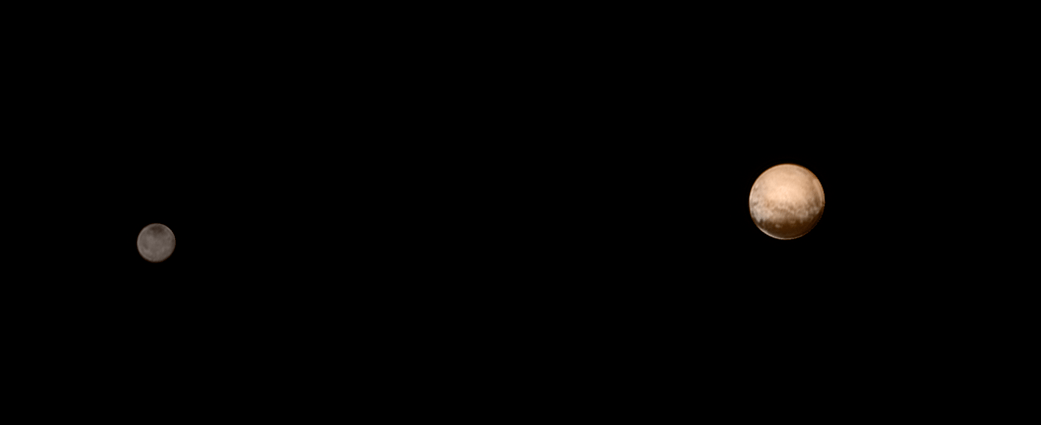
New imagery and spectral evidence from the Ralph instrument was presented that appears to show the flow of nitrogen ices in geologically recent times across a vast region. They appear to flow similar to glaciers on Earth. There are also carbon monoxide and methane ices mixed in with the water ices.
“We’ve only seen surfaces like this on active worlds like Earth and Mars,” said mission co-investigator John Spencer of SwRI. “I’m really smiling.”
“At Pluto’s temperatures of minus-390 degrees Fahrenheit, these ices can flow like a glacier,” said Bill McKinnon, deputy leader of the New Horizons Geology, Geophysics and Imaging team at Washington University in St. Louis.
“In the southernmost region of the heart, adjacent to the dark equatorial region, it appears that ancient, heavily-cratered terrain has been invaded by much newer icy deposits.”
“We see the flow of viscous ice that looks like glacial flow.”
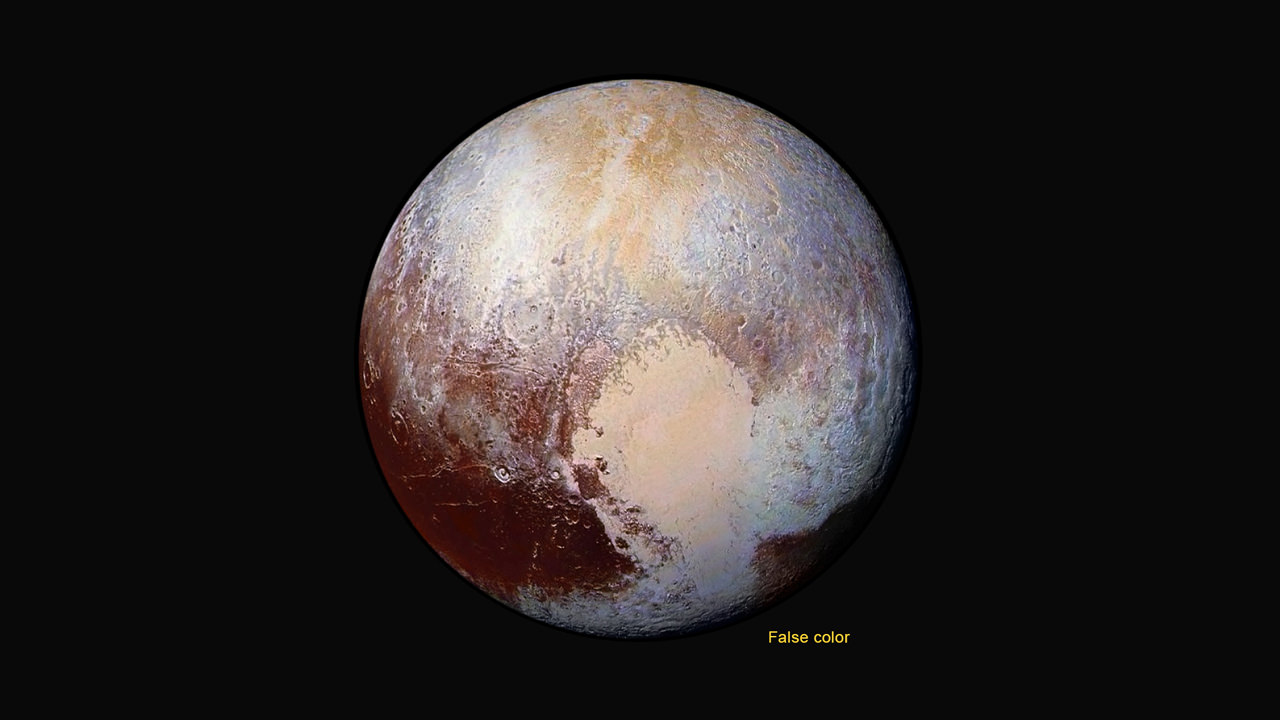
If the spacecraft remains healthy as expected, the science team plans to target New Horizons to fly by another smaller Kuiper Belt Object (KBO) as soon as 2018.
Watch for Ken’s continuing coverage of the Pluto flyby. He was onsite reporting live on the flyby and media briefings for Universe Today from the Johns Hopkins University Applied Physics Laboratory (APL), in Laurel, Md.
Stay tuned here for Ken’s continuing Earth and planetary science and human spaceflight news.
